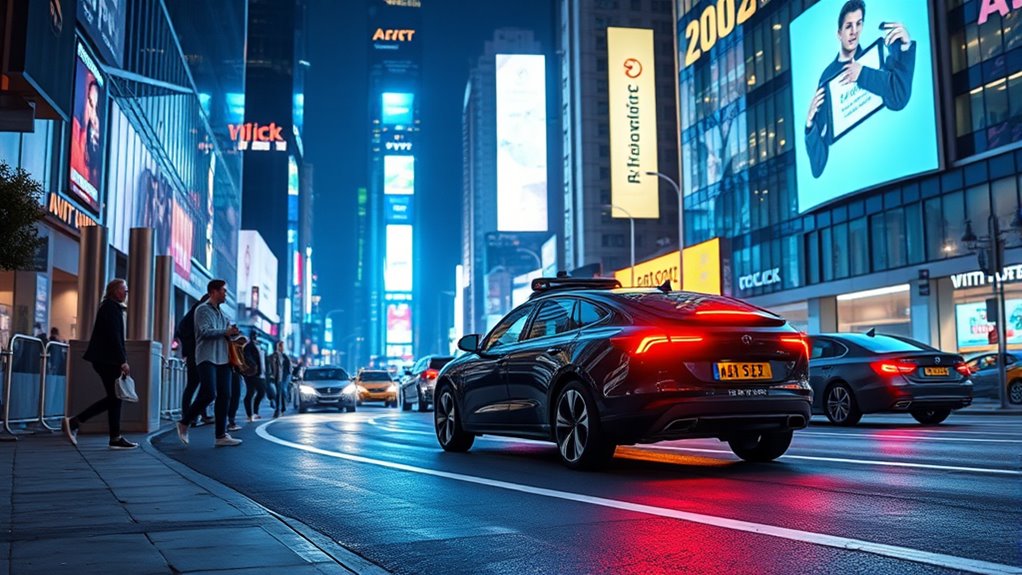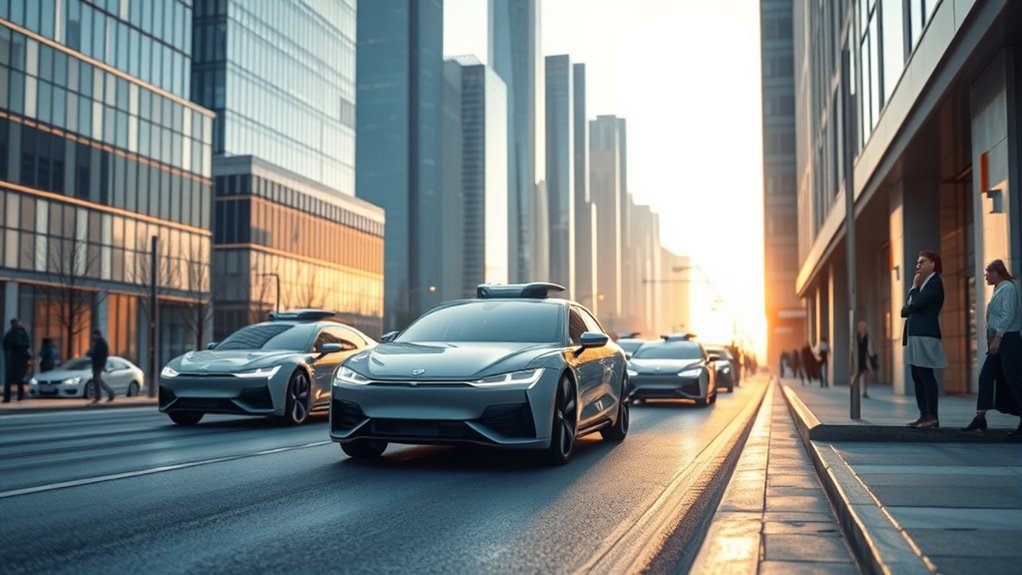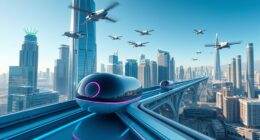By 2025, autonomous cars are increasingly common on urban streets thanks to major infrastructure upgrades, such as dedicated lanes, smart signals, and vehicle-to-infrastructure communication. Safety regulations and clear legal standards guarantee these vehicles operate reliably and securely. Numerous pilot projects and city partnerships show that self-driving cars are now part of everyday commuting, improving safety and traffic flow. If you’re curious how this transformation continues, there’s much more to explore about what’s next for autonomous mobility.
Key Takeaways
- Autonomous vehicles are now widely integrated into urban transportation systems by 2025.
- Infrastructure updates, including dedicated lanes and smart signals, support reliable self-driving car operation.
- Governments have established comprehensive safety standards and data security protocols for autonomous vehicles.
- Pilot programs and smart corridors demonstrate seamless vehicle-to-infrastructure communication in cities.
- The widespread adoption of self-driving cars has improved traffic flow, safety, and commuting efficiency.

Self-driving technology has made significant strides in 2025, transforming the way we commute and interact with vehicles. As autonomous vehicles become more prevalent on the roads, urban infrastructure is evolving to support this new era of transportation. Cities are redesigning streets to accommodate self-driving cars, adding dedicated lanes, smart traffic signals, and enhanced signage that communicate directly with autonomous systems. This integration helps improve traffic flow, reduce congestion, and boost safety. You’ll notice a smoother driving experience as urban planners prioritize connectivity between infrastructure and vehicle sensors, making autonomous travel more reliable and efficient.
Self-driving cars transform urban streets with dedicated lanes, smart signals, and seamless infrastructure integration for safer, smoother autonomous travel.
Alongside infrastructure updates, legal regulations play a vital role in shaping the deployment of self-driving cars. Governments and transportation authorities have established detailed frameworks that set safety standards, data security protocols, and operational guidelines. These regulations are designed to guarantee that autonomous vehicles meet strict safety benchmarks before they hit the roads. You don’t have to worry about unpredictable behavior or legal uncertainties anymore—rules are in place to protect everyone. Automated vehicle testing is now closely monitored, and there are clear procedures for handling accidents or malfunctions involving self-driving cars, giving users confidence in their safety and accountability.
The evolution of urban infrastructure and legal regulations isn’t just about making self-driving cars possible; it’s about creating an ecosystem that encourages widespread adoption. Cities are partnering with tech companies to pilot smart corridors that facilitate seamless vehicle communication, helping autonomous cars navigate complex urban environments with ease. These corridors use a combination of sensors, cameras, and data integration to optimize traffic management. Meanwhile, legal updates address issues like liability and privacy, clarifying who’s responsible in case of incidents and how data collected by autonomous vehicles is used. This transparency reassures users and encourages more to embrace self-driving technology.
Your daily commute is likely to become more predictable and less stressful as these advancements continue to unfold. With infrastructure designed to support autonomous vehicles and regulations that promote safety and accountability, the transition to driverless travel feels more tangible than ever. You can expect smoother rides, fewer traffic jams, and improved safety standards that benefit everyone on the road. The landscape of urban transportation is shifting, and while challenges remain, the combined efforts of infrastructure development and legal oversight are paving the way for autonomous cars to become a common sight in your city. In 2025, self-driving cars aren’t just a futuristic concept—they’re an integral part of your daily life.
Frequently Asked Questions
What Are the Legal Implications of Autonomous Cars in Different Countries?
You’ll face various legal implications with autonomous cars worldwide, especially around regulatory challenges and liability issues. Different countries set distinct rules for autonomous vehicle testing and deployment, which can complicate cross-border use. Liability concerns also arise—who’s responsible in an accident? Manufacturers, owners, or software developers? Remaining informed on each jurisdiction’s laws helps you navigate these complexities and ensures safer, compliant autonomous driving experiences.
How Do Autonomous Vehicles Handle Complex Weather Conditions?
Autonomous vehicles handle complex weather conditions by relying on sensor reliability and advanced weather adaptation systems. When snow, rain, or fog occur, your car uses radar, lidar, and cameras designed to adjust their sensitivity. These sensors work together to maintain accurate environment detection, ensuring safe navigation. While technology continues to improve, it is crucial to stay cautious and understand that weather still poses challenges for autonomous driving, despite these innovations.
What Cybersecurity Measures Protect Self-Driving Cars From Hacking?
Think of your autonomous car as a fortress, protected by robust cybersecurity protocols. These measures act like digital shields, preventing hacking attempts and unauthorized access. Engineers implement encryption, intrusion detection systems, and secure communication channels to guard your vehicle’s data. You can trust these advanced hacking prevention techniques to keep your self-driving car safe from cyber threats, ensuring your journey remains smooth, secure, and uninterrupted.
How Affordable Are Autonomous Vehicles for the Average Consumer?
Autonomous vehicles are becoming more affordable thanks to cost reductions in manufacturing and technology. You might find initial models priced higher, but as production scales up, prices drop, making them accessible for the average consumer. Additionally, self-driving cars can lower insurance costs due to advanced safety features and accident prevention systems. Over time, these factors will make owning an autonomous vehicle a practical and economical choice for many people.
What Are the Environmental Impacts of Widespread Autonomous Vehicle Adoption?
Imagine cities breathing easier as autonomous vehicles glide silently, like whispers among the streets. Widespread adoption reduces urban pollution by lowering electric vehicle emissions and optimizing traffic flow. Fewer idling cars mean cleaner air, healthier communities, and a smaller carbon footprint. Your shift to autonomous cars can transform urban environments, making them greener and more sustainable, as cleaner air replaces smog and cities breathe easier with each self-driving mile.
Conclusion
By 2025, autonomous cars aren’t just a dream—they’re taking over the roads, transforming your daily commute into a futuristic thrill ride. Imagine never worrying about traffic, accidents, or parking again; it’s like having a personal chauffeur 24/7. The future is here, and it’s faster, smarter, and more exhilarating than you ever thought possible. Buckle up—this revolution will change your life in ways you never imagined!










